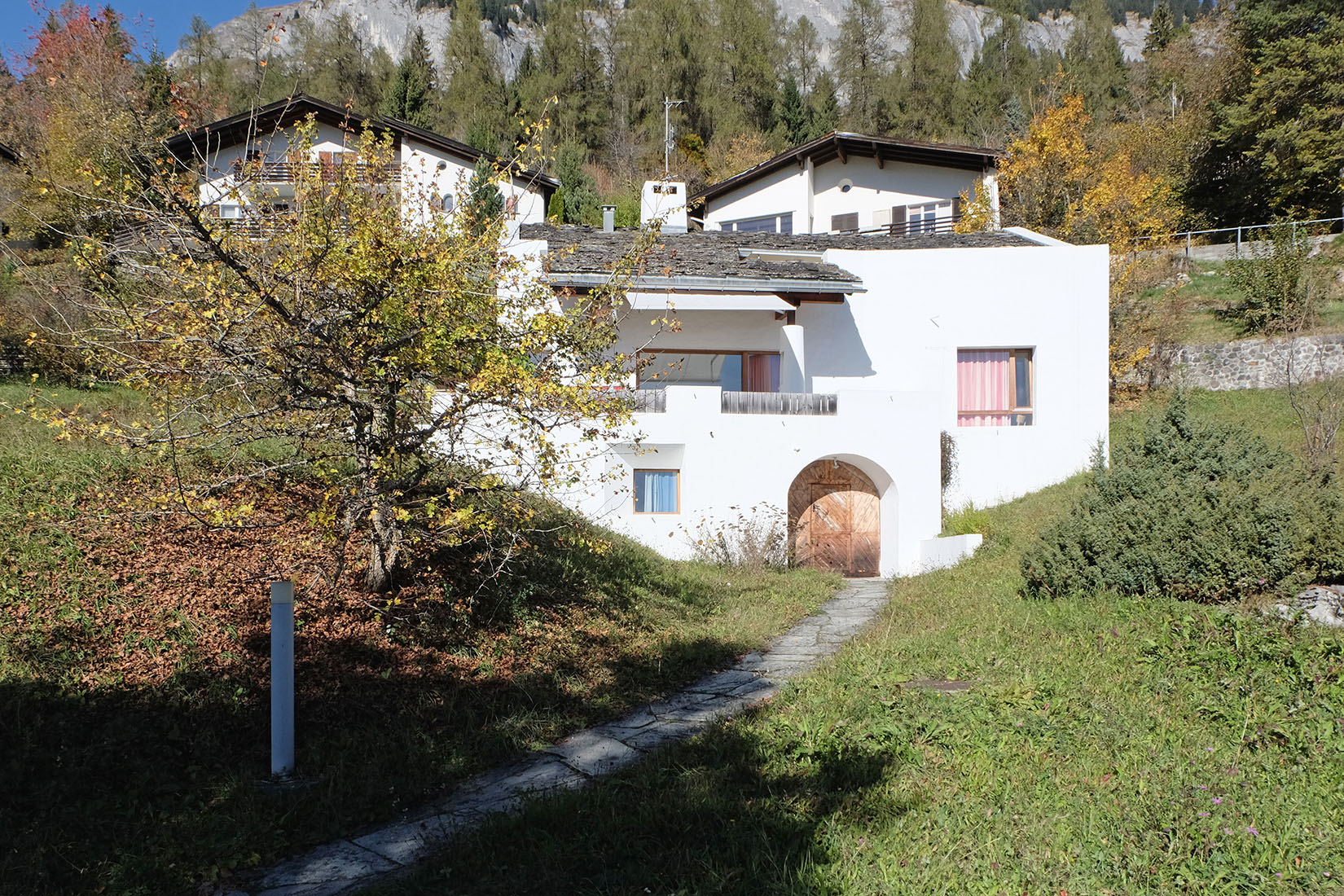 |
 |
 |
 |


Walter & Marlies Egg House
Via Plaids 29, Flims
1988 - 1990
The
residential building Walter and Marlies Egg in Flims, built from 1988 to
1990 on a steep hillside, is one of the late works by the architect
Rudolf Olgiati. Above a pedestal rises the two-storey main building
with an asymmetrical saddle roof. The pedestal is characterized by the
historic entrance door with an arch and a funnel-shaped window. From
the entrance the living floor is reached via a staircase. On this floor are
the kitchen with the living-dining area and a bedroom, a toilet and a
storeroom. The living room with fireplace opens generously to the
terrace, which is located above the mentioned base. The porch of the
terrace is supported on the one hand by a fully plastic concrete
support and on the other hand by a wooden strut. A half-spiral
staircase leads from this floor to the floor with
the bedrooms. A terrace appears as a generous roof incision. The building shows many of the architectural features
typical of Rudolf Olgiati. In addition to the features already
mentioned, it is important to observe the roofing with natural stone,
the cubic chimneys, the irregular arrangement of the windows and the
raised outer walls which largely conceal the roof.
Das 1988 bis 1990 in steiler Hanglage erbaute Wohnhaus Walter und Marlies Egg in Flims gehört zum Spätwerk des Architekten Rudolf Olgiati. Über einem Sockel erhebt sich der zweigeschossige Hauptbaukörper mit asymmetrischem Satteldach. Der Sockel wird durch die historische Eingangstüre mit Rundbogen und ein trichterförmiges Fenster charakterisiert. Vom Eingang gelangt man über eine Treppe in das Wohngeschoss. Hier befinden sich die Küche mit dem Wohn-Essbereich sowie ein Zimmer, eine Toilette und ein Abstellraum. Der Wohnraum mit Feuerstelle öffnet sich grosszügig zur Terrasse, welche sich über dem erwähnten Sockel befindet. Das Vordach der Terrasse wird einerseits durch eine vollplastische Betonstütze und andererseits durch eine hölzerne Strebe abgestützt. Eine halbgewendelte Treppe führt von diesem Stockwerk in das darüberliegende Stockwerlk mit den Schlafzimmern. Eine Terrase tritt als grosszügiger Dachausschnitt in Erscheinung. Das Gebäude weist zahlreiche der für Rudolf Olgiati typischen Architekturmerkmale auf. Nebst den bereits erwähnten Merkmalen gilt es die Dacheindeckung mit Naturstein, die kubischen Schornsteine, die unregelmässige Anordnung der Fenster sowie die hochgezogenen Aussenwände welche das Dach grösstenteils verbergen zu beachten.
Das 1988 bis 1990 in steiler Hanglage erbaute Wohnhaus Walter und Marlies Egg in Flims gehört zum Spätwerk des Architekten Rudolf Olgiati. Über einem Sockel erhebt sich der zweigeschossige Hauptbaukörper mit asymmetrischem Satteldach. Der Sockel wird durch die historische Eingangstüre mit Rundbogen und ein trichterförmiges Fenster charakterisiert. Vom Eingang gelangt man über eine Treppe in das Wohngeschoss. Hier befinden sich die Küche mit dem Wohn-Essbereich sowie ein Zimmer, eine Toilette und ein Abstellraum. Der Wohnraum mit Feuerstelle öffnet sich grosszügig zur Terrasse, welche sich über dem erwähnten Sockel befindet. Das Vordach der Terrasse wird einerseits durch eine vollplastische Betonstütze und andererseits durch eine hölzerne Strebe abgestützt. Eine halbgewendelte Treppe führt von diesem Stockwerk in das darüberliegende Stockwerlk mit den Schlafzimmern. Eine Terrase tritt als grosszügiger Dachausschnitt in Erscheinung. Das Gebäude weist zahlreiche der für Rudolf Olgiati typischen Architekturmerkmale auf. Nebst den bereits erwähnten Merkmalen gilt es die Dacheindeckung mit Naturstein, die kubischen Schornsteine, die unregelmässige Anordnung der Fenster sowie die hochgezogenen Aussenwände welche das Dach grösstenteils verbergen zu beachten.